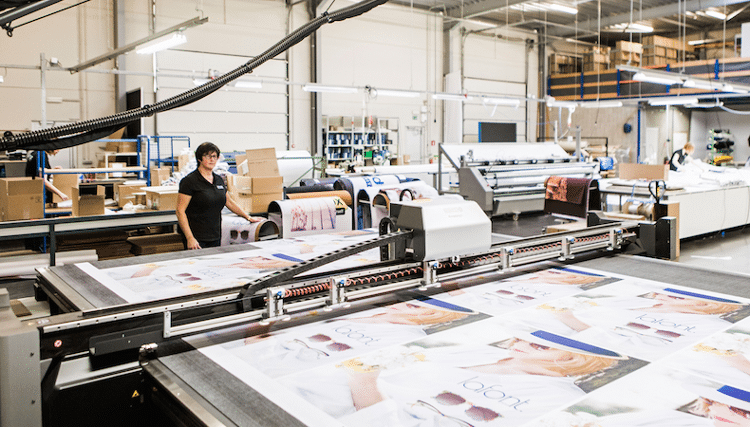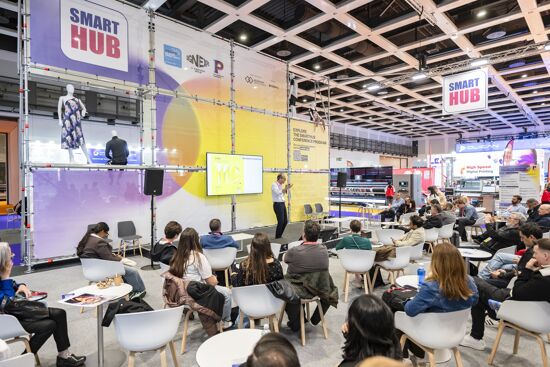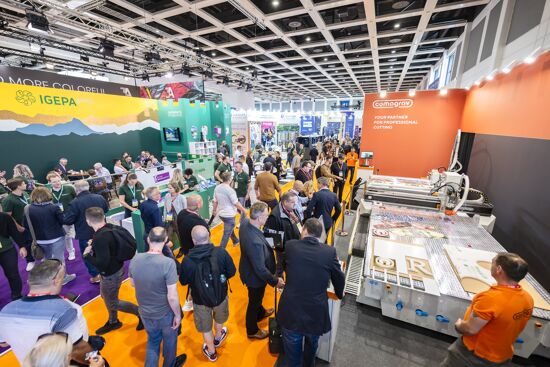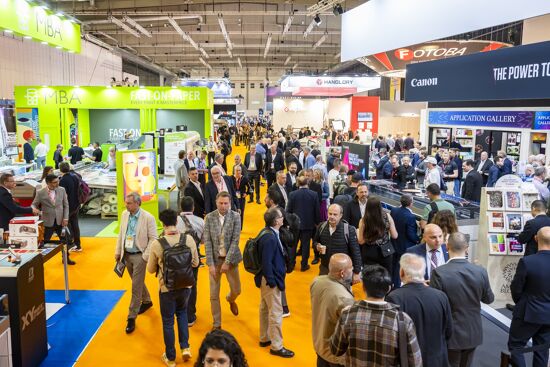Visix relies on Esko to increase throughput

Belgian textile firm Visix has invested in a Kongsberg C64 cutting table to help them increase throughput and remove a finishing bottleneck.
In addition to the 3.2-metre finishing machine that comes with Esko Automation Engine, the manufacturer of flags and banners based in Roeselare, Belgium, has also deployed Esko’s Device Manager.
“The 3.2-metre format for the cutting table is the same width as our grand format printers and downstream calender,” explains Stefaan Devlaminck, who is in charge of production. “We have found the most efficient textile run to be 20 meters long by 3.2 meters wide, and the Kongsberg fits perfectly into that flow.”
Following creation of print files using the Adobe Creative Suite, Visix uses i-cut Preflight, part of Automation Engine, to check for quality and bleed prior to printing. This process tags the file with XML metadata that guides it through the rest of the production process.
“The next step,” Devlaminck states, “is to create a test or proof for customer approval. Automation Engine helps us there as well, automatically generating the proof and establishing the necessary follow-up action items in an automated flow. Once we have customer approval, Automation Engine takes over again, allocating a barcode to the job and routing it to what we call a ‘gang run,’ or a funnel dedicated to each substrate. Files are then automatically nested or imposed to make optimum use of the substrate.”
This process has worked so well for Visix that Devlaminck reports that even though the company is able to produce much more work now, there is actually less overall waste. “And it saves us a huge amount of time,” he adds. “Before, all the nesting was manually calculated which took a lot of time and could be prone to error.”
And the automation doesn’t stop there. By adding Esko Device Manager, Devlaminck and his team benefit from automatic selection of cutting parameters and required cutting blades for each file from the XML metadata, generated by Automation Engine in a sequence that guarantees maximum production efficiency. Compensation settings within Automation Engine to automatically adjust for shrinkage or stretch are also important for the final product quality.
“We’re able to see exactly where in the process a job is at any given point in time, and this is an important benefit to us,” Devlaminck comments. “Device Manager shows us whether the file has been printed, and whether or not it has been cut. This helps us in planning and gives us instant access to information customers may request, related to the job status."
"The bottom line is that we can now seamlessly operate from file acceptance through final delivery in a highly automated fashion. Prepress is no longer a bottleneck, and mistakes are kept at a minimum. These solutions have taken Visix to the next level in terms of throughput, machine utilization, productivity and profitability, enhancing our craftsmanship even more while ensuring the best possible customer service.”
Topics
Interested in joining our community?
Enquire today about joining your local FESPA Association or FESPA Direct
Recent news

Industry Experts Explore the Evolution of Smart Manufacturing in the Textile Industry
A FESPA SmartHUB roundtable at Personalisation Experience 2025 discussed smart manufacturing's transformative impact on the textile industry. Experts highlighted the shift to on-demand customisation, driven by digital printing, data analytics, and automation. Key takeaways included enhanced machine control, significant waste reduction through intelligent software and colour management, and improved sustainability via energy efficiency and near-shoring, ensuring agility and environmental responsibility in textile production.

FESPA 2025 gathers leading visionaries from across the speciality print industry in Berlin
FESPA Global Print Expo 2025, European Sign Expo and Personalisation Experience (6 – 9 May 2025, Messe Berlin, Germany) welcomed Visionaries from across the speciality print industry to shape the future of print, develop forward-thinking business strategies, and explore innovative ways to translate emerging industry trends into tangible growth opportunities.

Exploring Cutting-Edge Textile Printing Innovation with Adobe Print Engine 7
Adobe PDF Print Engine 7, launched at FESPA Global Print 2025, significantly advances textile printing. Debbie McKeegan shares how it automates non-white substrate management and RGB colour handling, expands colour gamuts with in-RIP multicolour transparency blending, and streamlines workflows for efficiency and sustainability. This update boosts customisation, reduces waste, and positions businesses at the forefront of digital print innovation.

FESPA Global Print Expo 2025 - Overall Highlights
FESPA Global Print Expo, Europe's leading print and signage exhibition returned to Messe Berlin from 6 - 9 May 2025.